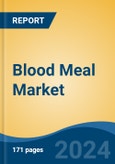Animal Feed is the fastest growing segment, Asia-Pacific is the largest regional market
Speak directly to the analyst to clarify any post sales queries you may have.
10% Free customizationThis report comes with 10% free customization, enabling you to add data that meets your specific business needs.
Key Market Drivers
The global demand for animal protein stands as a primary catalyst for the blood meal market, directly fueling the expansion of livestock and aquaculture sectors that rely on efficient feed ingredients. As global populations grow and dietary preferences shift towards increased meat consumption, the necessity for high-quality, protein-rich animal feed intensifies. This robust demand is evident in the aquaculture industry, where production has seen substantial growth.According to the Food and Agriculture Organization of the United Nations (FAO)'s 2024 edition of The State of World Fisheries and Aquaculture (SOFIA) report, published in June 2024, global aquatic animal aquaculture production reached an unprecedented 130.9 million metric tons in 2022, signifying a significant upward trend in animal protein sourcing. Such expansion necessitates a consistent supply of effective feed supplements to optimize animal growth and productivity, thereby directly increasing the utilization of blood meal.
Key Market Challenges
Stringent regulatory frameworks and concerns pertaining to animal-derived products pose a significant impediment to the expansion of the Global Blood Meal Market. These regulations, often varying by region and focusing on aspects such as processing methods, traceability, and prevention of disease transmission, introduce substantial operational complexities and elevated costs for producers. Compliance necessitates investments in specialized equipment, enhanced biosecurity measures, and extensive documentation, thereby increasing the overall cost of production.Key Market Trends
The global blood meal market is experiencing a significant trend towards enhanced focus on sustainable sourcing and supply chain traceability. This involves increasing efforts to ensure raw materials are sourced responsibly and their journey tracked transparently, addressing growing consumer and regulatory demands. According to the Brazilian Animal Rendering Association (ABRA) in August 2024, renderers in Brazil recovered over 4.7 million cubic meters of water in 2023, contributing to sustainable water recycling. This emphasis extends to major industry players; an October 2025 AInvest analysis noted Darling Ingredients' focus on circular economy strategies for supply chain resilience and environmental goals. Such initiatives are driving investments in technology and process improvements across the rendering sector.Key Market Players Profiled:
- Darling Ingredients Inc.
- The Boyer Valley Company, Inc.
- West Coast Reduction Ltd.
- Allanasons Pvt Ltd
- Sanimax ABP Inc.
- The Fertrell Company
- Terramar SBH
Report Scope:
In this report, the Global Blood Meal Market has been segmented into the following categories:By Application:
- Animal Feed
- Agriculture
- Others
By Source:
- Porcine Blood
- Poultry Blood
- Ruminant Blood
By Region:
- North America
- Europe
- Asia-Pacific
- South America
- Middle East & Africa
Competitive Landscape
Company Profiles: Detailed analysis of the major companies present in the Global Blood Meal Market.Available Customizations:
With the given market data, the publisher offers customizations according to a company's specific needs. The following customization options are available for the report.Company Information
- Detailed analysis and profiling of additional market players (up to five).
This product will be delivered within 1-3 business days.
Table of Contents
Companies Mentioned
The companies profiled in this Blood Meal market report include:- Darling Ingredients Inc.
- The Boyer Valley Company, Inc.
- West Coast Reduction Ltd.
- Allanasons Pvt Ltd
- Sanimax ABP Inc.
- The Fertrell Company
- Terramar SBH
Table Information
| Report Attribute | Details |
|---|---|
| No. of Pages | 180 |
| Published | November 2025 |
| Forecast Period | 2024 - 2030 |
| Estimated Market Value ( USD | $ 2.48 Billion |
| Forecasted Market Value ( USD | $ 3.08 Billion |
| Compound Annual Growth Rate | 3.6% |
| Regions Covered | Global |
| No. of Companies Mentioned | 8 |









